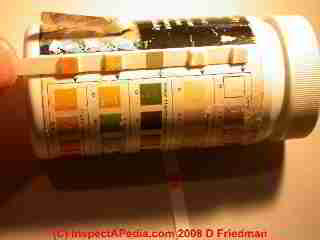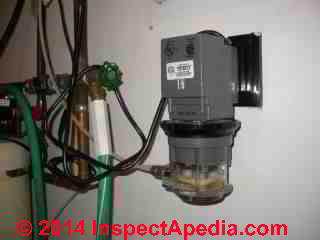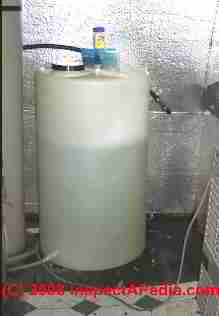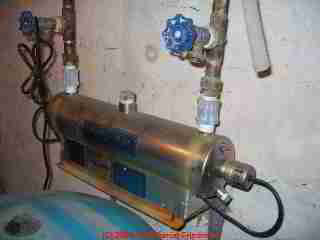 Does Chlorine in Drinking Water Harm the Septic Tank?
Does Chlorine in Drinking Water Harm the Septic Tank?
- POST a QUESTION or COMMENT about chlorinated drinking water and residential use
Effects of chlorinated drinking water on septic systems:
Does using a home chlorinator to disinfect drinking water risk harming the septic tank or drainfield? Discussed: What are the effects of a drinking water chlorinator on the septic system tank and drainfields? Does a drinking water treatment or purification system harm the septic tank or drainfield? Effects of reverse osmosis or RO systems on septic systems.
InspectAPedia tolerates no conflicts of interest. We have no relationship with advertisers, products, or services discussed at this website.
- Daniel Friedman, Publisher/Editor/Author - See WHO ARE WE?
Effects of Drinking Water Chlorinators or Use of Bleach on Septic Systems
 Is my chlorinator or chlorinated water going into a private septic system likely to harm the septic tank or drainfield?
Is my chlorinator or chlorinated water going into a private septic system likely to harm the septic tank or drainfield?
[Click to enlarge any image]
Do some septic systems require chlorine or other disinfectants?
Will chlorine, bleach, or Clorox™ damage the septic tank or leach fields?
This document explains how to extend the life of the septic system by being careful about what goes into it.
Here we discuss the environmental effects of chlorine introduced into building water systems from incoming water treatment and disinfection systems and the environmental effects of chlorine used at normal levels in household cleaners or in laundry bleach.
First lets say a word on chlorine in outgoing wastewater to be discharged into the environment. Some septic system designs include a final disinfection stage that may be used to reduce the level of pathogens in wastewater before it is discharged into the environment. Properly-designed and maintained, the wastewater discharge from those systems is not harmful to the environment, plants, animals, or waterways.
However, in general, the discharge of chlorine into the environment - into soils - is undesirable in both arid soils and in tropical or temperate soils. At sufficient concentrations chlorine in soils kills important soil bacteria necessary for both the break-down of other contaminants and for healthy plant life.
Finally, the discharge of chlorine into ocean waters or into bodies of fresh water is probably of no measurable consequence or of little consequence. Details are
at WASTEWATER BIOCOMPATIBILITY.
Using a chlorinator on well water

At homes where the water supply is not potable due to bacterial contamination, a common temporary solution is the installation of a chlorinator.
Often this consists of an injector which doses incoming water with chlorine, a holding tank to give the chlorine time to work, and a post-processing charcoal filter to remove the chlorine from the water.
It's preferable to find and correct the source of contamination.
In a properly-operating chlorinator the level of chlorine in the house drinking water will not harm the septic system.
Watch out: However, high levels of chlorine, such as from an improperly adjusted or malfunctioning chlorinator would be a problem for the occupants who would not want to be drinking such water, and might be a problem for the septic system too.
Details about Chlorinators for Drinking Water Disinfection
Details about how to install, use, troubleshoot or repair chlorinators for water disinfection & treatment are in our separate
article CHLORINATORS & CHARCOAL FILTERS.
Effects of chlorine treatment of well water on Water Tests & Real Estate Transactions
For a discussion of what happens when people dump chlorine into a well see
- CHEATING ON WATER TESTS - how people cheat on water bacteria or potability tests & what to do about it
- WELL CHLORINATION & SHOCKING - when & how to shock or sterilize a well
- WATER TEST INTERPRETATION - use of chlorine or other methods to treat contaminated water
Septic System Effects of Use of UV Lights as an alternative to drinking water chlorination

An alternative to chlorine for partial treatment of wellwater is the use of a UV light system. This method, used alone, will not add chemicals to the building water supply and thus it won't add chemicals (such as chlorine) to the septic tank, drainfield, or groundwater at the property.
UV (ultra violet) lights [photo] which are sold to treat bacterial contamination in water do not place any chemical into the water supply.
However if drinking water is contaminated with bacteria, a UV light is a not necessarily the best solution as other drinking water contaminants may be present too.
Septic System Effects of Use of an RO = reverse osmosis treatment system for drinking water
Unlike a chlorinator or a UV light system, a reverse osmosis system will add water volume load to a septic system, even though it won't add chemicals.
For a discussion of the effects of other water treatment systems on septic tanks and drainfields,
see REVERSE OSMOSIS CONCENTRATE DISPOSAL
Reader Q&A on Using Bleach in Septic systems
On 2018-11-02 by (mod) - normal household uses of bleach should not harm a septic tank
A normal household usage levels laundry bleach is not going to damage the septic tank.
Even though you're doing more laundry because you have more occupants and some babies, there's also more Wastewater being used so you're also diluting the bleach. However heavy usage of a septic system maybe more than its design can handle.
On 2018-11-02 y Erik
We have a septic system and a large family (10) with babies.
Is putting bleach into the laundry (as a disinfectant) going to adversely affect the septic system (hinder the helpful bacteria in the septic tank from doing its job of breaking down solids? How much bleach is safe to put it?
Question: can you use clorine bleach?
(May 26, 2011) Anonymous said:
can you use clorine bleach
Reply: in your washing machine yes; as an aerobic septic system final treatment, no
If you are asking if it's ok to use chlorine bleach at normal usage levels while doing laundry, yes that should not be a problem.
See TOILETS, DON'T FLUSH LIST for a list of things you should not flush down drains
Question:
(Aug 5, 2011) Don Winters said:
Is it advisable to use dishwasher detergent that contains chlorine or would it be better to avoid chlorine as much as possible in a septic system? I thought septic systems relied on bacterial action and it seems that chlorine could inhibit such action.
Reply:
Don, at normal household usage levels the chlorine in dishwasher detergent won't harm the septic system.
Search InspectApedia for - TOILETS, DON'T FLUSH LIST - for more detail.
(Oct 31, 2014) Anonymous said:
Hi Don, What do you consider normal levels from a dish machine?
Reply:
Anon:
The use of manufacturer-recommended dishwasher detergent products in the recommended doses should not harm the system. The physical quantity recommended varies a bit by product and whether it's a liquid or powder.
Question: why doesn't our drinking water chlorinator kill the bacteria in the septic tank?
(Oct 24, 2011) Gerry S said:
If chlorination kills harmful bacteria in drinking/tap water, why does it not kill the organisms in a septic tank/system as well?
Reply:
Gerry the ability of chlorine to kill bacteria depends on its concentration and the duration of exposure of the bacteria to the chlorine solution.
In a septic tank, at normal use levels, the concentration of household bleach is not enough to kill bacteria.
Question: on a Well/Septic System.
(Dec 9, 2012) clyde pearce said:
I am currently on a Well/Septic System. A new water plant is offering to pipe treated/chlorinated water to our home. Will the chlorine in the treated water ruin my septic system?
Reply:
Not at normal concentrations.
Question: can't get the bleach into the septic - pipe full
(Feb 29, 2016) Anonymous said:
Why is the pipe I put my bleach in full?
Reply:
Sounds as if your septic tank or outlet piping or drainfield are blocked or flooded.
Watch out: you should not be using bleach in your aerobic septic system.
See AEROBIC SEPTIC DISINFECTANTS - Calcium Hypochlorite
...
Continue reading at AEROBIC SEPTIC DISINFECTANTS - Pool Chlorine or select a topic from the closely-related articles below, or see the complete ARTICLE INDEX.
Or see these
Chlorine Disinfectant Articles
- AEROBIC SEPTIC SYSTEMS, ATUs - home
- AEROBIC SEPTIC DISINFECTANTS - Calcium Hypochlorite
- AEROBIC SEPTIC DISINFECTANTS - Pool Chlorine
- CHLORINE HAZARDS in WATER
- CHLORINE IMPACT on SEPTIC
- CHLORINE SOURCES in WATER
- CHLORINE SOURCES in WASTEWATER
- CHLORINATION WELL SHOCKING PROCEDURE
- CHLORINATORS & CHARCOAL FILTERS
- TOILETS, DON'T FLUSH LIST
Suggested citation for this web page
CHLORINE IMPACT on SEPTIC at InspectApedia.com - online encyclopedia of building & environmental inspection, testing, diagnosis, repair, & problem prevention advice.
Or see this
INDEX to RELATED ARTICLES: ARTICLE INDEX to SEPTIC SYSTEMS
Or use the SEARCH BOX found below to Ask a Question or Search InspectApedia
Ask a Question or Search InspectApedia
Questions & answers or comments about chlorinated drinking water and residential use
Try the search box just below, or if you prefer, post a question or comment in the Comments box below and we will respond promptly.
Search the InspectApedia website
Note: appearance of your Comment below may be delayed: if your comment contains an image, photograph, web link, or text that looks to the software as if it might be a web link, your posting will appear after it has been approved by a moderator. Apologies for the delay.
Only one image can be added per comment but you can post as many comments, and therefore images, as you like.
You will not receive a notification when a response to your question has been posted.
Please bookmark this page to make it easy for you to check back for our response.
IF above you see "Comment Form is loading comments..." then COMMENT BOX - countable.ca / bawkbox.com IS NOT WORKING.
In any case you are welcome to send an email directly to us at InspectApedia.com at editor@inspectApedia.com
We'll reply to you directly. Please help us help you by noting, in your email, the URL of the InspectApedia page where you wanted to comment.
Citations & References
In addition to any citations in the article above, a full list is available on request.
- New York State Department of Health, APPENDIX 75-A WASTEWATER TREATMENT STANDARDS - INDIVIDUAL HOUSEHOLD SYSTEMS , [PDF] New York State Department of Health, 3 February 2010, retrieved 3/1/2010, original source: https://www.health.ny.gov/regulations/nycrr/title_10/part_75/appendix_75-a.htm
- [1] Drinking Water from Household Wells - PDF, U.S. EPA, Original source last retrieved 2/13/2013, original source: http://www.epa.gov/privatewells/pdfs/household_wells.pdf
- [2] Salzman, James, Drinking Water: A History, Overlook (2012), ISBN-10: 1590207203, ISBN-13: 978-1590207208, Quoting product description:
In Drinking Water, Duke University professor and environmental policy expert James Salzman shows how drinking water highlights the most pressing issues of our time--from globalization and social justice to terrorism and climate change--and how humans have been wrestling with these problems for centuries. From the aqueducts of Rome to the revolutionary sewer system in nineteenth-century London to today’s state-of-the-art desalination plants, safety and scarcity of water have always been one of society’s most important functions. - [3] Soll, David, Empire of Water: An Environmental and Political History of the New York City Water Supply, Cornell University Press, (2013), ISBN-10: 0801449901, ISBN-13: 978-0801449901, Quoting: product review
"Empire of Water chronicles the fascinating story of New York City's water supply, which comes mostly from reservoirs in the Catskills and, remarkably, is unfiltered. That's because the city has spent billions of dollars and decades of effort working with residents, businesses, and governments in the Catskills to protect the reservoirs from pollution caused by runoff from roads, farms, and dairies. This meticulously researched and persuasively reasoned history explores the change in New York City’s attitude toward water, from indifference to profligate water waste and environmental pollution to stalwart champion of water conservation and protection. The best histories shed light on the past as they illuminate the present. Empire of Water is in this category. By protecting the ecosystem services provided by a pristine watershed in northern New York, the city avoided having to spend $8 billion to build a treatment plant. As we confront water shortages in the United States and across the world, Empire of Water teaches that business as usual—looking for new oases and relying on massive engineering solutions—no longer makes sense. We must acknowledge nature’s limits and work within them to secure a sustainable future for coming generations."—Robert Glennon, Regents’ Professor and Morris K. Udall Professor of Law and Public Policy, University of Arizona, author of Unquenchable: America's Water Crisis and What To Do About It - [4] Mithen, Steven, Thirst: Water and Power in the Ancient World, Harvard University Press (2012), ASIN: B00EDZ5OHC. Quoting product review at Amazon:
Water is an endangered resource, imperiled by population growth, mega-urbanization, and climate change. Scientists project that by 2050, freshwater shortages will affect 75 percent of the global population. Steven Mithen puts our current crisis in historical context by exploring 10,000 years of humankind’s management of water. Thirst offers cautionary tales of civilizations defeated by the challenges of water control, as well as inspirational stories about how technological ingenuity has sustained communities in hostile environments.
... Mithen blends archaeology, current science, and ancient literature to give us a rich new picture of how our ancestors lived. Since the Neolithic Revolution, people have recognized water as a commodity and source of economic power and have manipulated its flow. History abounds with examples of ambitious water management projects and hydraulic engineering—from the Sumerians, whose mastery of canal building and irrigation led to their status as the first civilization, to the Nabataeans, who created a watery paradise in the desert city of Petra, to the Khmer, who built a massive inland sea at Angkor, visible from space.
As we search for modern solutions to today’s water crises, from the American Southwest to China, Mithen also looks for lessons in the past. He suggests that we follow one of the most unheeded pieces of advice to come down from ancient times. In the words of Li Bing, whose waterworks have irrigated the Sichuan Basin since 256 bc, “Work with nature, not against it.” - Access Water Energy, PO Box 2061, Moorabbin, VIC 3189, Australia, Tel: 1300 797 758, email: sales@accesswater.com.au Moorabbin Office: Kingston Trade Centre, 100 Cochranes Rd, Moorabbin, VIC 3189
Australian supplier of: Greywater systems, Solar power to grid packages, Edwards solar systems, Vulcan compact solar systems, water & solar system pumps & controls, and a wide rage of above ground & under ground water storage tanks: concrete, steel, plastic, modular, and bladder storage tanks. - Smart Tank, Installation Instructions [ copy on file as /water/Smart_Tank_Flexcon.pdf ] - , Flexcon Industries, 300 Pond St., Randolph MA 02368, www.flexconind.com, Tel: 800-527-0030 - web search 07/24/2010, original source: http://www.flexconind.com/pdf/st_install.pdf
- Typical Shallow Well One Line Jet Pump Installation [ copy on file as /water/Jet_Pump_Grove_Elect_Jet_Pumps.pdf ] - , Grove Electric, G&G Electric & Plumbing, 1900 NE 78th St., Suite 101, Vancouver WA 98665 www.grovelectric.com - web search -7/15/2010 original source: http://www.groverelectric.com/howto/38_Typical%20Jet%20Pump%20Installation.pdf
- Typical Deep Well Two Line Jet Pump Installation [ copy on file as /water/Jet_Pump_Grove_Elect.pdf ] - , Grove Electric, G&G Electric & Plumbing, 1900 NE 78th St., Suite 101, Vancouver WA 98665 www.grovelectric.com - web search -7/15/2010 original source: http://www.groverelectric.com/howto/38_Typical%20Jet%20Pump%20Installation.pdf
- Water Fact Sheet #3, Using Low-Yielding Wells [ copy on file as /water/Low_Yield_Wells_Penn_State.pdf ] - , Penn State College of Agricultural Sciences, Cooperative Extension, School of Forest Resources, web search 07/24/2010, original source: http://pubs.cas.psu.edu/FreePubs/pdfs/XH0002.pdf
- Crystal Clear Supply provides portable ceramic water filter purifiers and portable reverse osmosis water treatment equipment - see http://www.crystalclearsupply.com/category_s/7.htm
- Handbook of Disinfectants and Antiseptics, Joseph M. Ascenzi (Editor), CRC, 1995, ISBN-10: 0824795245 ISBN-13: 978-0824795245 "The evaluation of chemical germicides predates the golden age of microbiology..." -
This well-focused, up-to-date reference details the current medical uses of antiseptics and disinfectants -- particularly in the control of hospital-acquired infections -- presenting methods for evaluating products to obtain regulatory approval and examining chemical, physical, and microbiological properties as well as the toxicology of the most widely used commercial chemicals. - Potable Aqua® emergency drinking water germicidal tablets are produced by the Wisconsin Pharmacal Co., Jackson WI 53037. 800-558-6614 pharmacalway.com
- Principles and Practice of Disinfection, Preservation and Sterilization (Hardcover)
by A. D. Russell (Editor), W. B. Hugo (Editor), G. A. J. Ayliffe (Editor), Blackwell Science, 2004. ISBN-10: 1405101997, ISBN-13: 978-1405101998.
"This superb book is the best of its kind available and one that will undoubtedly be useful, if not essential, to workers in a variety of industries. Thirty-one distinguished specialists deal comprehensively with the subject matter indicated by the title ... The book is produced with care, is very readable with useful selected references at the end of each chapter and an excellent index. It is an essential source book for everyone interested in this field. For pharmacy undergraduates, it will complement the excellent text on pharmaceutical microbiology by two of the present editors."
The Pharmaceutical Journal: "This is an excellent book. It deals comprehensively and authoritatively with its subject with contributions from 31 distinguished specialists. There is a great deal to interest all those involved in hospital infection ... This book is exceptionally well laid out. There are well chosen references for each chapter and an excellent index. It is highly recommended." The Journal of Hospital Infection.: "The editors and authors must be congratulated for this excellent treatise on nonantibiotic antimicrobial measures in hospitals and industry ... The publication is highly recommended to hospital and research personnel, especially to clinical microbiologists, infection-control and environmental-safety specialists, pharmacists, and dieticians."
New England Journal of Medicine: City Hospital, Birmingham, UK. Covers the many methods of the elimination or prevention of microbial growth. Provides an historical overview, descriptions of the types of antimicrobial agents, factors affecting efficacy, evaluation methods, and types of resistance. Features sterilization methods, and more. Previous edition: c1999. DNLM: Sterilization--methods. - U.S. Army Field Manual 21-10, Field Hygiene and Sanitation, 1988, web search 07/02/2010, original source: http://www.enlisted.info/field-manuals/fm-21-10-field-hygiene-and-sanitation.shtml
The purpose of this manual is to assist individual soldiers, unit commanders, leaders and field sanitation teams in preventing disease and environmental injuries. The manual provides information on preventive medicine measures (PMM) to the individual soldier as well as essential information for the unit commander, unit leaders, and the unit field sanitation team on applying unit level PMM. - When Technology Fails, Matthew Stein, Chelsea Green Publisher, 2008,493 pages. ISBN-10: 1933392452 ISBN-13: 978-1933392455, "... how to find and sterilize water in the face of utility failure, as well as practical information for dealing with water-quality issues even when the public tap water is still flowing". Mr. Stein's website is www.whentechfails.com/
- In addition to citations & references found in this article, see the research citations given at the end of the related articles found at our suggested
CONTINUE READING or RECOMMENDED ARTICLES.
- Carson, Dunlop & Associates Ltd., 120 Carlton Street Suite 407, Toronto ON M5A 4K2. Tel: (416) 964-9415 1-800-268-7070 Email: info@carsondunlop.com. Alan Carson is a past president of ASHI, the American Society of Home Inspectors.
Thanks to Alan Carson and Bob Dunlop, for permission for InspectAPedia to use text excerpts from The HOME REFERENCE BOOK - the Encyclopedia of Homes and to use illustrations from The ILLUSTRATED HOME .
Carson Dunlop Associates provides extensive home inspection education and report writing material. In gratitude we provide links to tsome Carson Dunlop Associates products and services.

